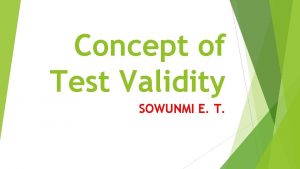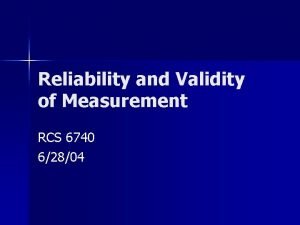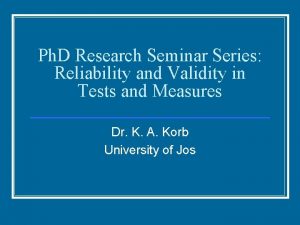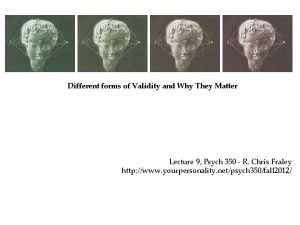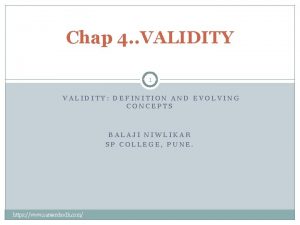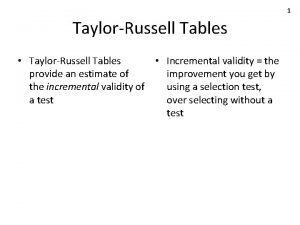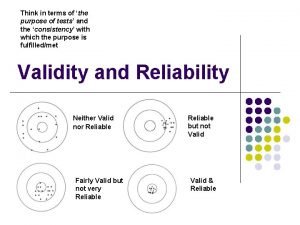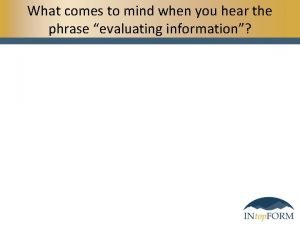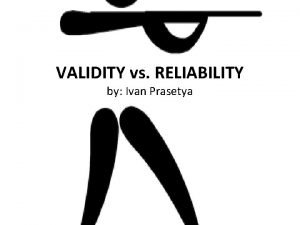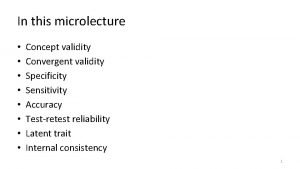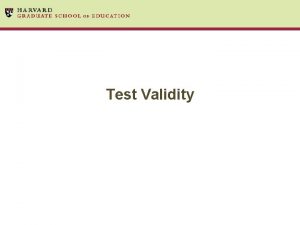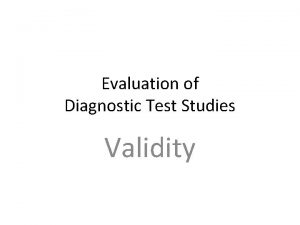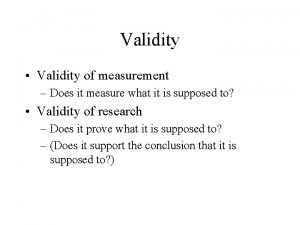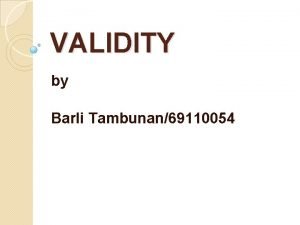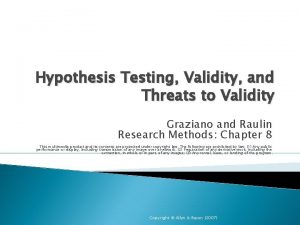Concept of Test Validity SOWUNMI E T Meaning














- Slides: 14

Concept of Test Validity SOWUNMI E. T.

Meaning and Nature of Test Validity deals with the degree to which a measures what it claims to measure. Test validity is the degree to which the test measures what it is supposed to measure. Reliability has more to do with consistency of a measure (repeatability) while validity has to do with accuracy (how accurately it measure what it is purported to measure from the start).

Validity is a matter of degree in nature, which means that it ranges from low through medium to high. The statistics for indicating the degree of validity is known as coefficient of validity which ranges from zero to one.

Methods of Measuring of an Instruments Validity 1. Content Validity: it involves the systematic examination of the test content to determine whether it covers a representative sample of the behaviour domain it is purported to measure. It could be checked by subject specialist or panel experts or It could also be done by preparing a table of specification. The closer the test contents to the subject matter, the higher the content validity.

2. Criterion-Related Validity: It correlate or compare the test with other existing standard measures (criteria). Criterion related validity looks at the relationship between a test score and an outcome. Example: intelligent quotient tests are often validated against measures of academic performance (the criterion) NOW, If the test data and criterion data are collected at the same time, this is referred to as Concurrent validity evidence. . If the new test is validated by a comparison with a currently existing criterion, we have concurrent validity.

Criterion-Related Validity (contd. ) If the test data are collected first in order to predict criterion data collected at a later point in time, then this is referred to as Predictive validity evidence. Predictive validity measures the degree to which a test accurately predicts or foretell a criterion that will occur in the future. It refers to the power or usefulness of test scores to predict future performance.

3. Construct validity: It is referred to as the degree to which a test/instrument measures the underlying theoretical construct it is supposed to measure. It is the extent to which a test captures a specific trait known as construct. In order to demonstrate construct validity, evidence that the test measures what it purports to measure as well as evidence that the test does not measure irrelevant attributes are both required. These are referred to as convergent and discriminant validity. i. convergent validity: if the two different tests end up ranking students similarly i. e when two different tests measures related skills. Ii. discriminant validity: providing evidence that two tests that do not measure closely related skills or types of knowledge do not correlate strongly.

Methods of establishing construct validity: Correlations with other tests that has been proven valid for the same trait or construct. Criterion group studies: when a test is administered to groups of students’ judged to be good or poor in a construct and it was proven so at the end of an administered test. Analysis of the mental process required by the test Comparing pre-test and post-test scores of persons exposed to some relevant treatment: it indicate how a treatment or condition may or may not affect a particular set of learners.

4. Face Validity: It is simply an estimate as to whether a test appears to measure what it claims to measure. It can be related to the question of whether a nonprofessional testers such as parents think the test is appropriate or not appropriate. A direct measurement of face validity is obtained by asking people to rate the validity of a test as it appears to them. The question that the face validity provides its answer is how much does a test look like an appropriate measure of the skills or body of knowledge concerned?

Principles for Test Validity Appropriate interpretation: tests are valid to the degree that evidence which supports their appropriateness and correctness can be identified. Appropriate uses: a test is valid to the degree by which evidence that supports their correctness and appropriateness use of the test result. Appropriate values: when the values implied by them are appropriate. Appropriate consequences: when the consequences of these interpretations and uses are consistent with appropriate values.

Factors affecting Test Validity These factors has been categorized into four main headings (a) Factors in the test: Difficulty level of test items should be able to discriminate effectively between the good and poor students Lack of clear the testee. Poor instructions: test that lack in this tend to confuse quality of test items: test items may be inappropriate for the cognitive level of the respondents thereby invalidating the results. Test items should not be vague (it should be clear not having different meaning to different testees) Test length: a test must not be too short nor too long otherwise it shows that the test do not adequately represent the content or has been over-stretched or over emphasis.

(a) Factors in the test (contd. ) Difficult vocabulary: when a test items contain difficult words, it is more or less measuring another trait which is not the achievement in that subject. Identifiable patterns of answers: when students identify the pattern of answer in multiple choice tests, they easily guess the answer to some items. This tends to lower the validity of test result. (b) Factors in test administration and scoring: factors such as cheating, undue assistance given to students, insufficient time and unreliable scoring of essay answers will tend to reduce the validity of test results.

Factors affecting Test Validity (contd. ) (C) Factors affecting validity coefficients: The larger the spread of scores, the higher the validity coefficient. Therefore, factors such as speed of test and item difficulty which reduces discrimination and spread of scores may reduce the validity coefficient. (d) Factors affecting students responses: variables such as sex (gender), age, and personality traits. Likewise, unhealthy physical and psychological conditions of the testing hall, emotional disturbance of the students may prevent students from achieving maximally.

End of the first topic.
 Criterion related validity definition
Criterion related validity definition Test validity means
Test validity means Validity
Validity Reliability in research example
Reliability in research example Criterion validity
Criterion validity Examples of concurrent validity
Examples of concurrent validity Taylor russell tables
Taylor russell tables Criterion validity meaning
Criterion validity meaning Definition of ideal self
Definition of ideal self Perbedaan selling concept dan marketing concept
Perbedaan selling concept dan marketing concept When you hear history what comes to your mind
When you hear history what comes to your mind Validity vs reliability
Validity vs reliability Face validity definition
Face validity definition Convergent validity definition
Convergent validity definition Content validity
Content validity

